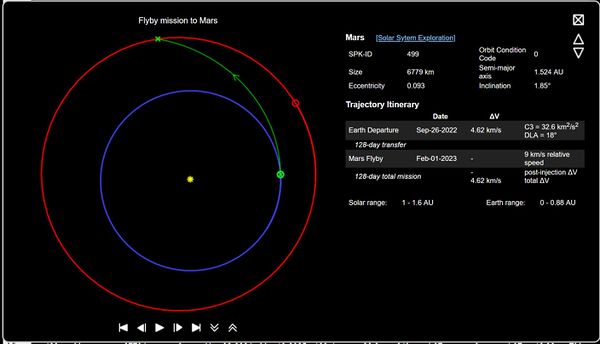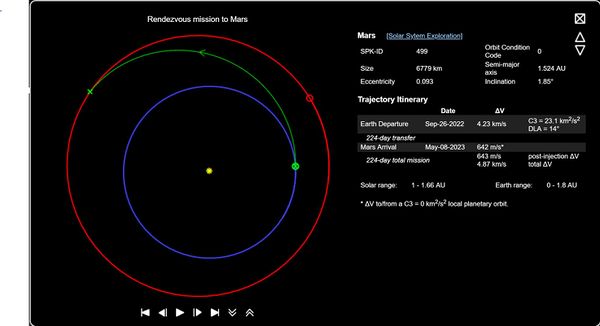Difference between revisions of "Aerobraking"
(Add a paragraph of technical details from the 1990 MSFC paper on Mars aerocapture.) |
|||
| Line 1: | Line 1: | ||
| − | Aerobraking is | + | Aerobraking is an [[Astronautics|astronautical]] technique used by mission scientists to reduce the height of spacecraft orbits by allowing atmospheric drag to slow the spacecraft's velocity. Often the [[solar panel|solar panels]] onboard orbiters can be used to maximize and control the amount of drag applied to the craft. This technique will ultimately minimize the requirement for the use of [[propellant|propellants]] (to slow the craft down), thereby optimizing cost effectiveness. |
This technique was used to great effect on missions such as the [[ExoMars Trace Gas Orbiter]] in 2017, [[Mars Reconnaissance Orbiter]] in 2006 and [[Mars Odyssey]] in 2001, and is standard practice when spacecraft are being inserted into orbit or when a reduction in velocity is required. | This technique was used to great effect on missions such as the [[ExoMars Trace Gas Orbiter]] in 2017, [[Mars Reconnaissance Orbiter]] in 2006 and [[Mars Odyssey]] in 2001, and is standard practice when spacecraft are being inserted into orbit or when a reduction in velocity is required. | ||
| Line 16: | Line 16: | ||
The images show orbits determined by the NASA Ames research center trajectory planner tool<ref>NASA Ames Research Center, "Trajectory Browser", web tool. https://trajbrowser.arc.nasa.gov/traj_browser.php?maxMag=25&maxOCC=4&chk_target_list=on&target_list=mars%0D%0A&mission_class=oneway&mission_type=flyby&LD1=2020&LD2=2030&maxDT=200&DTunit=days&maxDV=5&min=DT&wdw_width=-1&submit=Search#a_load_results</ref>. | The images show orbits determined by the NASA Ames research center trajectory planner tool<ref>NASA Ames Research Center, "Trajectory Browser", web tool. https://trajbrowser.arc.nasa.gov/traj_browser.php?maxMag=25&maxOCC=4&chk_target_list=on&target_list=mars%0D%0A&mission_class=oneway&mission_type=flyby&LD1=2020&LD2=2030&maxDT=200&DTunit=days&maxDV=5&min=DT&wdw_width=-1&submit=Search#a_load_results</ref>. | ||
| − | == References == | + | ==References== |
[[category:Spaceflight science]] | [[category:Spaceflight science]] | ||
| + | <references /> | ||
Latest revision as of 07:32, 27 August 2021
Aerobraking is an astronautical technique used by mission scientists to reduce the height of spacecraft orbits by allowing atmospheric drag to slow the spacecraft's velocity. Often the solar panels onboard orbiters can be used to maximize and control the amount of drag applied to the craft. This technique will ultimately minimize the requirement for the use of propellants (to slow the craft down), thereby optimizing cost effectiveness.
This technique was used to great effect on missions such as the ExoMars Trace Gas Orbiter in 2017, Mars Reconnaissance Orbiter in 2006 and Mars Odyssey in 2001, and is standard practice when spacecraft are being inserted into orbit or when a reduction in velocity is required.
Aerocapture
Aerocapture is a subcategory of aerobraking. Atmospheric drag is used to reduce velocity to a point the vehicle can enter a stable orbit with a minimum or no propellant burn. Aerocapture can be the prelude to descent and entry into the atmosphere. Aerocapture can subject a vehicle to very high accelerations, and for future manned mission will require very precise attitude controls for the vehicles.
For example, in a typical manned Mars mission concept, using aerobraking cuts the initial vehicle mass in half[1] compared to purely propulsive capture, even including the mass of a large heatshield required for aerobraking. This is because aerobraking can scrub off several km/s of arrival velocity per aerobraking pass without using propellant. However, high arrival velocities can impose significant radiative and convective heating loads on the heatshield, and sustained accelerations on the crew of as much as 5g for several minutes. A typical Mars aerobraking atmosphere entry corridor has a periapsis of 40-50km and a height tolerance of less than 5km, requiring accurate navigation and aerodynamic control.
Aerocapture can be used to shorten travel times between Earth and Mars, as well as with other planetary bodies in the solar system with atmospheres. The time of travel to Mars, for a similar deltaV expense, can be reduced from nine months, 270 days, for a Hohmann transfer orbit to about four months (128 days). This would reduce radiation doses by over 60% compared to the Hohmann transfer. This trajectory uses 4.62 km/s of deltaV. SpaceX Starship is designed for about 6 km/s of deltaV.
This type of orbit is much more dangerous than the Hohmann transfer orbit, as it requires a successful capture or the vehicle and crew are left on an elliptical solar orbit that may not approach any planet for centuries. The return velocity of Apollo was about 11 km/s, so the 9 km/s relative speed shown in the illustration should be manageable.
The images show orbits determined by the NASA Ames research center trajectory planner tool[2].
References
- ↑ Braun, Powell, Hartung, "The effect of interplanetary trajectory options on a manned Mars aerobrake configuration ," 1990 NASA Marshall Technical Report. https://ntrs.nasa.gov/citations/19900016720
- ↑ NASA Ames Research Center, "Trajectory Browser", web tool. https://trajbrowser.arc.nasa.gov/traj_browser.php?maxMag=25&maxOCC=4&chk_target_list=on&target_list=mars%0D%0A&mission_class=oneway&mission_type=flyby&LD1=2020&LD2=2030&maxDT=200&DTunit=days&maxDV=5&min=DT&wdw_width=-1&submit=Search#a_load_results








